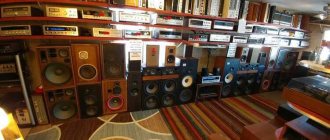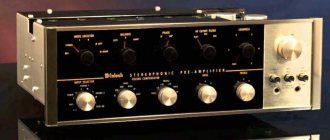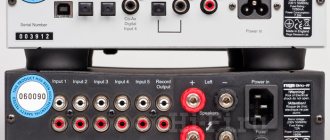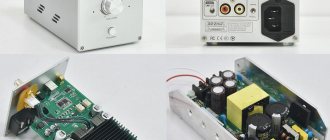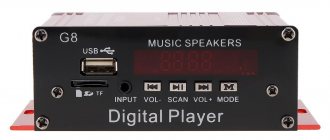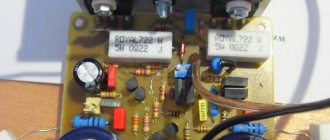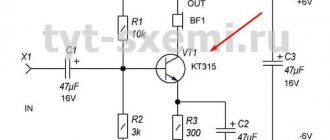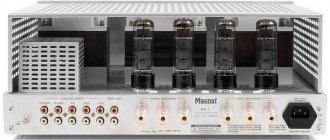Stereo amplifiers are not as simple and limited in their capabilities as they used to be. The days when they were equipped with only analog inputs and outputs and a couple of speaker terminals are long gone.
Laptops, smartphones and streaming services are becoming increasingly popular sources for music playback, and the integrated amplifier is keeping up with its modern competitors. Many now include built-in digital-to-analog converters (DACs), turntable phono preamps, USB inputs, and Bluetooth streaming capabilities. Some even have network streaming built-in.
We've put together a selection of the best integrated amplifiers on the market, offering a wide selection of devices with different functionality at different prices. We are confident that everyone can find a component that suits any budget and meets user requirements. Trust us, these devices will make your music system sound new.
Cambridge Audio CXA61
Price: $990
Power: 80 W per channel
Remote Control: No
Phono stage: n/a
Digital inputs: coaxial S/PDIF, Toslink
USB: Yes
Bluetooth: built-in aptX HD codec
Headphone output: Yes
Dimensions (HSH): 11.5 x 4.3 x 34.1 cm
The CXA81 is part of the second series of CX components, which was originally released by Cambridge Audio in 2014. In addition to this stereo amplifier, the line also includes a second amplifier, a CD transporter and a network audio streamer. According to Cambridge Audio, the second-generation CX series has been redesigned to bring "full-fledged hi-fi into the home at an affordable price" (the CXA81 is the most expensive product in the range).
Designed from the ground up, the CXA81 offers several new features over its predecessor, the CXA80. These include the inclusion of an ESS Technology Saber ES9016K2M D/A converter, an enhanced USB input supporting 32-bit/384kHz PCM and DSD256 quality, and built-in Bluetooth aptX HD for streaming from mobile devices up to 48kHz/24-bit. On the rear panel there are connectors for three digital inputs (two optical, one coaxial), four analog inputs, two balanced (XLR) analog inputs, a USB input, as well as outputs for connecting a subwoofer and preamplifier.
You can buy Cambridge Audio CXA61 HERE
Anthem STR
Price: $4499
Power: 200 W per channel (8 ohms)
Remote control: Yes
Phono stage: n/a
Digital Inputs: 2 Toslink optical, 2 coaxial, AES/EBU digital audio input with balanced XLR connection
Ethernet port: Yes
USB: Yes
Bluetooth: No
Headphone output: Yes
Dimensions (HH): 17.2 x 43.2 x 44.5 cm
The Anthem STR is available in black or all-silver. Weighing in at 18kg, it's moderately light for a Class AB amplifier (and stays virtually cool), rated to output 200Wpc into 8 ohms, 400Wpc into 4 ohms, or 550Wpc into 2 ohms across the entire audio range. with less than 1% total harmonic distortion (THD).
The STR power amplifier stage is built around a single large toroidal transformer with oversized filter capacitors and load control circuitry for optimal performance. Its nominal impedance of 2 ohms should allow the STR to work effortlessly with virtually any modern speaker that features low impedance, at least in a narrow portion of its frequency range.
In addition to ARC, the Anthem STR offers more than the typical array of integrated amplifier features. There are five analog inputs (four sets of single-ended, one balanced); Digital conversion and signal processing can be done with each of them. Six digital inputs include two optical TosLink, two coaxial and one AES/EBU, each supporting up to 24-bit/192kHz. The asynchronous USB Type B digital input accepts PCM up to 32/384 and DSD at 2.8 or 5.6 MHz. All internal digital processing is done in PCM at 32/192, so all digital inputs support this resolution, including DSD as well as analogue inputs.
You can buy Anthem STR HERE
We test integrated amplifiers in the price range of 60-100 thousand rubles.
In the new year, it is logical to return to the review of the amplifier market, this time concentrating on the upper hi-fi (or, if you prefer, lower high-end) area. The realities of our existence are such that in this range, only single-block structures meet the quality criteria without reservations. Let's deal with them
The price range around $3,000 can be considered a transition zone. Here two different concepts meet and come into contact - Hi-Fi with its principles of good quality and reasonable sufficiency and High End as an area of creativity less limited by budget. There is also room for new ambitious companies that are gaining a place in the market. Just ten years ago, this symbolic watershed lay lower. However, now in the audio sector, as elsewhere, the situation is changing towards an inexorable rise in prices. Therefore, some design compromises are inevitable in this segment. Exactly what they are depends heavily on which side of the divide a firm positions itself on. Brands that are traditionally considered hi-fi, in their top-end models make a complete set, with many auxiliary options (including smart controls and interfaces that facilitate integration into a home theater system), rich switching and other pleasant service functions. At the same time, if you approach it quite strictly, the actual quality of the same switching units or, for example, power supply may leave much to be desired. On the other hand, high-end companies, in an attempt to get closer to the people, are releasing low-end budget lines. In this case, we can count on the expected values of the top class, in particular insensitivity to the nature of the load, even complex ones, and an individual signature. But in order to preserve (at least partially) proprietary resource-intensive developments, manufacturers save on other things, most often on the same switching and ease of use. However, a paradigm shift is also possible, for example, turning to class D in power amplifiers. The choice, as always, is made in accordance with personal preferences and taking into account the specifics of other components of the system (especially acoustics, recalling the remark about the problem of high-quality power supply to the amplifier). Be that as it may, there is plenty to choose from, and the problem of cost optimization has a solution.
Test system
1. Source – Bryston BCD-1 CD player 2. Speaker systems – PMC OB1i 3. Analog unbalanced interconnects and speaker cables – Analysis Plus 4. Analog balanced interconnects – Analysis Plus Silver Oval-in
Test material
1. G. Purcell, “King Arthur” (Harmonia Mundi, 195200) 2. G. I. F. Biber, “Mystery Sonatas” (ALPHA, 038) 3. S. Prokofiev, “Scythian Suites” (PHILIPS, 473 600-2) 4. Ludwig van Beethoven, Piano Sonata No. 23 in F minor “Appassionata” (DG, 457 296-2) 5. W. Baumgratz, “Organ Landscape” (MDG, 319 0962-2 MDG Gold) 6. Tory Amos "Little Earthquakes" (Atlantic, AT82358) 7. Blackmore's Night "Beyond the Sunset" (SPV, 087-69900) 8. Rammstein "Mutter" (Motor Music, 549 639-2) 9. The Who "Quadrophenia" ( MCA MCAD2-11463) 10. Manowar “Fighting the World” (ATCO, 7567-90563-2) 11. Anorexia Nervosa “Redemption Process” (Listenable Rec., POSH063)
The prices indicated in the article are indicative.
Exposure 3010 S2
Price - 63,000 rubles.
The English company Exposure, created in 1974 by John Farlow, has studio roots and enjoys authority in the world of rock. In particular, Led Zeppelin and Pink Floyd recorded their albums with the help of its amplifiers. The brand's reputation remains unshakable thanks to its focus on quality and preservation of traditions
The design of Exposure 3010 S2 corresponds to the corporate philosophy - it is distinguished by high quality of the element base combined with proven circuit solutions. The pre-amplifier operates in class A, and the presence of two Pre-out outputs allows the use of more muscular power amplifiers, moreover, using a bi-amping circuit. The power supply is equipped with a serious power toroidal transformer, the signal circuits contain audiophile high-quality capacitors, and fast bipolar transistors operate at the output. The aluminum body with an oval polished front panel is painted black, which harmonizes well with the red LED backlight. As an option, you can install a phono stage module for MC or MM type cartridges. The high-quality RCA jacks of the line inputs deserve special praise for their durable mounting and spacious arrangement. The picture is slightly spoiled by four pairs of terminals for speaker cables for biwiring, which allow switching exclusively with bananas. Another fly in the ointment was the control panel - universal, but with a large number of small, close and awkwardly placed buttons. The Exposure 3010 S2 sounds very clear, precise and focused throughout the entire range, with the exception of the bass register. The noticeable buzzing in certain parts of the musical compositions and the constant muffled vagueness of the low frequencies could be largely due to the poor choice of acoustics, which turned out to be too heavy for a British amplifier. In general, the slightly dry, sharp and detailed sound could use some timbral richness and physicality. The plans failed to develop properly in depth, although the separation of sources in width was very good, perhaps even a little more collected and focused than necessary. All instrumental lines (except bass lines) were drawn neatly and clearly. The playing of the Big Symphony Orchestra seemed a little flat and bright, and the ingestion of microdynamic contrasts led to the presentation being perceived as somewhat static. A completely different picture was observed when playing records of rock music and metal. Boredom, if present, completely evaporated, the sticks rhythmically and transparently hit the cymbals, beating the beats cleanly and without the slightest harshness. The guitars, without being overly full and dense, began their themes very energetically and cheerfully, the bass guitar clearly supported the drummer's kicks. There were no signs of inhibiting lows or a flattened, failed voice; the elastic, groovy drive met all expectations, and the legs began to dance on their own. The Exposure 3010 S2 excelled on Blackmore's Night's "Shadow of the Moon" and Tori Amos' "Little Earthquakes," performing them with poise, impact, and celebration (though the bass was still fuzzy).
Measurement results:
Exposure 3010 S2 demonstrated a behavior of amplitude-frequency response that is unique for modern amplification devices. In the range from 20 Hz to 20 kHz there is a fairly stable section with low unevenness (0.7 dB), which does not cause any suspicion, but above 20 kHz a sharp decline begins, reaching a level of –3 dB at a frequency of 42 kHz (Fig. 1). The level of distortion is average in the selection (Fig. 2). The SOI value increases with increasing frequency and decreasing load resistance, but in any case remains beyond the audible limit. The maximum output power is 130 W per channel at 8 ohms. The high damping factor (370) also helps to work with a 2 ohm load. In this case, the amplifier is ready to deliver up to 315 W. The signal separation between channels is quite high throughout the entire frequency band (Fig. 3).
Passport data: Name – Exposure 3010 S2 | Input resistance, kOhm – 17 | Input sensitivity, µV – 250 | Output power (at 8 Ohm load, 1 kHz), W – 110 x 2 | Frequency response, Hz – 20—20,000 (level +/-0.5 dB) | Harmonic distortion (1 kHz),% – less than 0.03 | Signal-to-noise ratio, dB – more than 100 | Channel separation (20—20,000 Hz), dB – more than 60 | Audio inputs – stereo pairs RCA (5), Tuner, Phono | Audio Outputs – Pre-out (2) | Power consumption (8 Ohm, both channels), VA – less than 400 | Dimensions, cm – 11.5 x 44 x 30 | Weight, kg – 11
Ratings: Design - 90% Build quality - 95% Sound - 85% Ergonomics - 85%
Final grade - 90%
Pros: fast and easy sound, clear drawing of instrumental lines, good detail Cons: problems with the lower bass when working with a complex load
Conclusion: An amplifier that remembers its rock roots.
He plays academic music rather dryly and sharply, with a certain emotional coldness. But in energetic, catchy compositions, his rhythm, drive and clarity are in full demand. Electrocompaniet Prelude PI-2
Price - 100,000 rubles.
The new Prelude series from the Norwegian Electrocompaniet is considered initial, but the models included in it are designed according to proprietary recipes (in particular, with fully balanced circuitry). The second integrated device in the line with index PI-2 differs from its younger brother in greater power
The electronic volume control in the new amplifier is identical to that used in the older models EC4.8 and EC4.9. The power supply is equipped with a 400 VA toroidal transformer and a bank of Nippon Chemi-Con capacitors in an 80,000 µF filter. The maximum peak current can exceed 50 A. The front panel of the Prelude PI-2 is made from a single piece of 20 mm thick brushed aluminum, and the sides and top are made from a single bent steel sheet. Serious attention was paid to the problem of ventilation - most of the lid and part of the side walls and bottom are occupied by numerous slots through which the body is visible through the sides. The layout of circuit elements is absolutely symmetrical. The RCA and XLR input jacks, as well as the speaker terminals, are quite simple, although they are well secured on the rear panel. Upon inspection, it turned out that the “bananas” of the speaker cables do not fully fit into the terminals and are poorly fixed, and therefore thick and long wires can fall out under their own weight. The screen with a bright blue display does not create a particularly original, but calm combination with the silver body. The weightless plastic remote control is densely filled with buttons and inscriptions explaining their purpose, which is not very convenient. The strongest side of the model is the performance of classical music of different styles. Immediately after listing the shortcomings - which boiled down to the fact that when playing difficult fragments there were rhythmic fills, distortions on the forte, the violins sometimes squealed - you can safely throw them out of your head and move on to the advantages. All the material was played emotionally correctly and very musically, we listened to it with pleasure and understood it without problems - right up to the most complex recordings. I liked the soft and rounded sound with subtle details, vibrations and tremor of timbres, small noise overtones, not done in a harsh manner at all. Timbral richness should be assessed as rather average, but the sound was harmonious and transparent, with slightly smoky contours. When necessary, there was grace and thoughtfulness, in other places and in other fragments giving way to rapid movement and free fortes with an abundance of air and maintaining the proportions of sounds and planes. The bass is not meaty or hard, but flexible and beautiful, with a certain limitation of detail. I really liked the vocals, both classical and non-academic, for their expressiveness and fullness of voices. I was pleased with the quality of high frequency in non-academic genres. The percussion was played clearly, transparently and without the slightest dirt, and the varied texture of hitting the cymbals with sticks and brushes was even unexpectedly surprising. Excellent rich “talking” guitars with their elastic riffs noticeably enhanced the mood and ensured perfect timing. Any recordings always sounded tasty and interesting, except that in the fastest and hardest fragments there was still a lack of tenacity and clarity and the attack felt soft.
Measurement results:
The record low frequency response unevenness of the Electrocompaniet Prelude PI-2 amplifier in the audio frequency range (0.08 dB) does not have a significant deterioration in the supra-tonal region (Fig. 1). The roll-off at 80 kHz is 0.71 dB. In terms of maximum output power, the device is an outsider in our test. It delivers only 95 W into an 8 Ohm load, but its design and, in particular, the energy-intensive power supply allow the PI-2 to cope with low-impedance loads much better than many competitors. So, at 2 Ohms it already delivers 265 W with virtually no increase in distortion in the working area, thereby catching up and even surpassing some participants (Fig. 2). The damping coefficient is very high - 370. There is practically no signal penetration between channels (Fig. 3). The attenuation does not drop below 70 dB even in the upper octave.
Passport data: Name – Electrocompaniet Prelude PI-2 | Input resistance, kOhm – 47 | Input sensitivity, µV – 250 | Output power (at 8 / 4 / 2 Ohm load, 0.2% THD), W – 100 / 150 / 220 x 2 | Frequency response, Hz – 1—200,000 (level –3 dB) | Harmonic distortion,% – less than 0.006 | Signal-to-noise ratio, dB – more than 100 | Channel separation, dB – more than 120 | Audio inputs – stereo RCA pairs (2), stereo XLR pairs (2) | Audio outputs – no | Output resistance, Ohm – 0.03 | Energy consumption (idle), W – 100 | Dimensions, cm – 7.7 x 42 x 34 | Weight, kg – 14
Ratings: Design - 90% Build quality - 90% Sound - 95% Ergonomics - 85%
Final grade - 90%
Pros: excellent timbres, vocals and detail, accurate conveyance of mood Cons: sometimes there is a little lack of density and pressure, softened presentation of music of energetic genres
Conclusion: An emotionally gifted device with a transparent, subtle and captivating signature.
The playback flaws are not at all criminal and are compensated by outstanding musicality. Slight tranquility and softness do not benefit only a small number of records T+A Power Plant MK II
Price - 92,000 rubles.
This time, German “theory and practice” received a digital application. The new E series includes an interesting device with computer capabilities and a full network connection, called Music Player. The logical pair for it was the Class D amplifier - Power Plant
The updated version of the Power Plant MK II amplifier belongs to the E series of the German company T+A, focused on high-quality reproduction of a wide variety of content (and not just traditional media). Despite its digital nature, the device has retained a number of proprietary values, such as the motorized ALPS volume control and the use of operational amplifiers with their own wiring and power supply. The power supply contains a toroidal transformer with a power of 330 VA and a bank of capacitors with a capacity of 33,000 μF. In addition to it, an additional power supply unit is designed to perform service functions. The large, solid body with sleek shapes and the absence of ventilation holes evokes associations with an aluminum case. The design of the front panel is typically recognizable for T+A products: a large volume knob and a headphone output on the right, plus a scattering of small round control buttons for selecting an input, equalizer options, channel balance, etc. Equally common is such a peculiar feature as the absence of a remote control DU. However, the amplifier can be controlled, for example, from the remote control of a multimedia player when connecting the devices via the proprietary E-Link bus. Switching groups are organized with obvious space savings and on rather modest connectors. The only exception is two pairs of WBT terminals for speaker cables. When describing the sound of the T+A Power Plant MK II, you will have to repeat yourself for a long time, risking getting bored with the constant use of the word “best”: the best scene with the most drawn plans, the best detail of the sound picture, intelligibility and clarity of timbres, the clearest impeccable rhythm, the most distinct feeling the scale and density of the sound wave and so on. But the most interesting thing (excuse the tautology) is, of course, that the model’s style completely lacks some of the negative features inherent in amplifiers operating in class D. A good, full and non-ringing organ; detailed formed bass, drawn with a straight line; excellent, soft and clear brass instruments; distinct strings, with overtones and texture of play; scale and authenticity - what is class D here? This is an extremely decent device that declares classical values. The singers' voices pleased us with their fullness of timbres and emotions, liveliness and open manner of performance. In general, vocalists and solo instruments were drawn large and prominently, and the playing of a symphony orchestra was accompanied by a feeling of volume and mass of sound, an abundance of air, and some kind of joyful feeling was born. The magnificent pure fortes evoked a consenting smile of pleasure. Energetic genres were presented with absolutely no harshness, extremely powerfully and quickly, in a concert style, with excellent groovy drive. The sound was delicious, perfectly balanced, very clear and intelligible. In terms of fascination, all attempts by other devices to reproduce this test material were not even close. And only with the fastest bass pumping with two bass drums in the track Anorexia Nervosa, the lows became slightly crumpled and chattered.
Measurement results:
The T+A Power Plant amplifier is very sensitive to changes in load resistance, as evidenced by almost all measured indicators. On the frequency distortion graph, this manifests itself primarily in a change in the signal bandwidth and uneven characteristics (Fig. 2). Thus, with a load of 2 Ohms at a frequency of 20 kHz, a drop of more than 3 dB is detected. With an 8-ohm load, the upper cutoff frequency shifts noticeably to the right, but at the same time, the output signal level increases noticeably in the supra-tonal region (Fig. 1). As the load resistance decreases, the level of nonlinear distortion products also increases. The maximum output power at high frequencies is noticeably lower than at mid and low frequencies (110 W versus 150, at 8 Ohms). The dumping factor is 160, which is more than enough for this device. The signal-to-noise ratio is 108 dBA.
Passport data: Name – T+A Power Plant MK II | Input resistance, kOhm – 20 | Input sensitivity, µV – 250 | Output power (at 8/4 Ohm load), W – 140/240 x 2 | Frequency response, Hz – 1–60,000 (level –3…+0 dB) | Harmonic distortion,% – less than 0.005 | Signal-to-noise ratio, dB – not specified | Channel separation, dB – more than 80 | Audio inputs – stereo RCA pairs (5) | Audio outputs – RCA stereo pair, Pre-out, headphones (3.5 mm mini-jack) | Energy consumption, W – not specified | Dimensions, cm – 12 x 44 x 39 | Weight, kg – 13
Ratings: Design - 90% Build quality - 95% Sound - 95% Ergonomics - 85%
Final grade - 95%
Pros: large and vividly depicted soloists, excellent timbres and rhythm, joyful naturalistic presentation Cons: no remote control, inconvenient and cramped connection connectors
Conclusion: An excellent, highly versatile amplifier, which gave out a little only at the most loaded extreme. He performs works of any musical genre cleanly, lively, richly, when necessary - in a concert style, with air and excellent volume, and ideally in the mood
Anthem Integrated 225
Price - 70,000 rubles.
The name Sonic Frontiers is well known to lovers of classic stereo and connoisseurs of high-quality and comfortable sound. Since 1998, Sonic Frontiers has been part of Paradigm and continues to produce high-quality equipment under the Anthem brand. Anthem's product portfolio extends beyond just stereo components and includes an extensive line of multi-channel AV processors, receivers and amplifiers for home theater applications.
The Anthem Integrated 225 amplifier's signal circuits use metal film resistors and foil capacitors. The power supply contains a toroidal transformer and two Nichicon capacitors in the filter, with a total capacity of 30,000 uF. The preamplifiers are equipped with precision voltage regulation circuits of ±15 V. The power amplifier has a completely symmetrical circuit with three pairs of bipolar transistors on each arm. Large radiators for cooling the output stages, the design of which was calculated and simulated on a computer, ensure efficient heat removal. The design of the heavy (almost twenty kilogram) model makes one want to characterize it as a traditional and perhaps even a little old-fashioned device. Almost over the entire area of the top cover of the all-metal case made of thick (2.5 mm) steel sheet there are many ventilation slots. The RCA input jacks are placed closely, literally right next to each other. The good news is that the balanced input has been moved to operational space. The acoustic terminals do not require the use of bi-wiring and are quite simple in appearance, however, the “bananas” of the cables are fixed in them well and reliably. On the front panel made of silver brushed aluminum there are control buttons and knobs of different sizes; there is no display. The remote control, a kind of solid brick made of decent velvety plastic, is universal and teachable, backlit, the main hot buttons are conveniently located. Anthem Integrated 225 demonstrated the richest and richest sound in the test, especially in the low frequency range. The lower register of the organ, the piano, and the large orchestral drum made a significant contribution to the overall picture. In terms of tonal details and intelligibility, the amplifier is an intermediate option between the T+A Power Plant and the Electrocompaniet Prelude PI-2. True, the stage performed by Anthem was not as deep and extended, there was less air and openness than that of more expensive competitors, but this did not in any way impede the enjoyment of listening. Yes, there was a slight lack of feeling of the overall sound field and coherent after-tones, which was especially noticeable in the playing of the Big Symphony Orchestra. However, fans of large and weighty sound with a fair amount of warmth will fully approve of such a presentation, which contrasts so pleasantly with the brittle and large sound of models striving for artificial detail. At the same time, the device played rock and, somewhat controversially, metal compositions perfectly. Let us note that the pressure and drive that traditionally distinguish North American hi-fi are fully manifested in the style of Anthem Integrated 225. Dense and powerful bass, confident transmission of rhythm, biting attack in the high-frequency register - everything is in place. But brutal genres were played with some mechanicalness and a tendency to simplify. However, this is one of the best devices in our test.
Measurement results:
The Anthem Integrated 225 amplifier has a wide operating bandwidth and at the same time a very smooth frequency response (Fig. 1). A roll-off of 0.5 dB is detected only at 80 kHz, and unevenness in the audio frequency region does not exceed 0.12 dB. Such remarkable frequency parameters are maintained with increasing output signal power, which reaches 280 W at 8 ohms. The device does not give up when working with a low-impedance load and produces a record 615 W at 2 ohms in the test. The level of nonlinear distortion is stable over a wide range of frequencies and powers and remains unchanged on average at the level of 0.01% (Fig. 2). The signal-to-noise ratio is also record-breaking - 112 dB. But the signal interpenetration between channels inexorably increases with increasing frequency, and in the HF region the attenuation becomes below 60 dB (Fig. 3).
Passport details: Name – Anthem Integrated 225 | Input impedance / Phono in, kOhm – 30 / 47 | Input sensitivity, mV – 250 | Output power (at 8 Ohm load, 20-20,000 Hz, THD less than 1%), W – 225 x 2 | Frequency response, Hz – 20–20,000 (level –0.15…+0 dB) | Harmonic distortion (1 / 20 kHz, 100 W, 8 Ohms), % – 0.01 / 0.03 | Signal-to-noise ratio, dB – 105 | Channel separation (100—10,000 Hz), dB – more than 57 | Audio inputs – RCA stereo pair (5), Phono, XLR stereo pair | Audio outputs – stereo pair RCA, Pre-out | Power consumption (at 8 Ohms), W – 300 (maximum 800) | Dimensions, cm – 14.9 x 43.8 x 45.7 | Weight, kg – 19.4
Ratings: Design - 85% Build quality - 90% Sound - 90% Ergonomics - 90%
Final grade - 90%
Pros: large textured sound, full, textured timbres Cons: some rhythmic fuzziness, not always focused bass
Conclusion: An amplifier with a spectacular, thick and rich sound, perfect for lovers of large images and chamber presentation. Dramatic symphonic music can play somewhat disjointedly, while hard-style recordings can play simply and straightforwardly
Arcam FMJ A38
Price — 79,900 rub.
The abbreviation FMJ stands for Faithful Musical Joy, and the A38 integrated circuit can really give cause for joy - thanks to the updated design of the low-noise preamplifier, the circuit with the shortest signal path, the presence of audiophile components and switching wealth
Arcam technology, designed and assembled in Cambridge, England, represents the union of advanced design ideas and reasonable economical sufficiency. The completely audiophile filling of the FMJ A38 amplifier - a decent-sized toroidal power transformer, Stargate and Rubicon capacitors, four-layer printed circuit boards - occupies a neat but modest-sized case, whose contribution to the weight of the device is by no means the main one. The top and side walls are made of bent steel sheet 1 mm thick. The front panel is made of brushed aluminum to match the body and is painted in a gray-black “wet asphalt” color. The amplifier chassis is made using Acousteel technology, which uses a sandwich of two steel sheets with a polymer layer between them to dampen resonances and vibrations. In terms of switching capabilities and the number of different available options, this is the most richly equipped participant in the test (and an additional phono preamplifier module for MM type cartridges is also available). The presence of a preamplifier output and a separate “power” input will allow you to improve the system in the future if desired. The front panel features a large volume control and a monochrome green screen that displays information on the current operating modes of the component. The facade is densely dotted with small control buttons of the same size, and there is also a headphone output. The silver plastic universal remote control is quite convenient and is capable of commanding eight branded devices. Despite some initial doubts, our test acoustics were not able to completely upset the amplifier, so the lower limit of the load recommended by the manufacturer (4-16 Ohms) can be taken seriously. However, the limited dynamics reserve (due to the low sensitivity of the PMC OB1i speakers) was still felt. On the volume scale, which has 72 units, we had to set it to more than 60 to make the signal level acceptable for the test. At the same time, in most musical fragments the sound was very decent, pleasant and calm, with strongly muffled noise overtones and gently leveled details. In fast parts there was commendably little confusion and fills, the amplifier perfectly maintained the tempo and rhythm. But in general, the performance of classical music is not the strength of the British apparatus, since the timbres turned out to be too smooth and formal, and the size of the instruments and the volume of sound were significantly reduced. Not too intense and overloaded metal compositions, and especially vocal jazz, blues and soft rock were performed very pleasantly, sunny and in the right mood. This is where the ability to maintain rhythm while maintaining a clear musical pattern came in very handy. Some complaints can be made about the treble, especially the very muffled percussion with medium resolution. The volume and feel of the room were also sometimes lacking. However, there were no problems in the vocal range, and a good catchy rhythm pulled out quite a lot of recordings and brought a lot of positive emotions.
Measurement results:
Frequency fluctuations in the audio region of the amplifier are quite insignificant. The unevenness of the characteristics in this area does not exceed 0.3 dB and appears only at the beginning of the low-frequency range (Fig. 1). The HF roll-off at 80 kHz is 0.81 dB. The maximum output power at a load of 8 Ohms is 140 W and remains virtually unchanged for any signal frequency, which cannot be said about the level of nonlinear distortion (Fig. 2). In the low-frequency region, the SOI value is thousandths of a percent (0.003%, 80 Hz, 0.5 Pmax), and at high frequencies it is already hundredths (0.017%, 10 kHz, 0.5 Pmax). Nevertheless, according to this indicator, the Arcam amplifier is the best in our selection. The signal interference between channels is below the threshold of audibility over the entire range of audible frequencies (Fig. 3). Of the minuses, the relatively low damping coefficient (95) should be noted.
Passport data: Name – Arcam FMJ A38 | Input impedance, kOhm – 10 | Input sensitivity, mV – 250 | Output power (with a load of 8 / 4 Ohms, 20-20,000 Hz, THD less than 0.5%), W – 100 / 140 x 2 | Frequency response, Hz – 20—20,000 (level not specified) | Harmonic distortion (1 kHz, 8 Ohms), % – 0.005 | Signal-to-noise ratio, dB – 104 | Channel separation, dB – not specified | Audio inputs – stereo pairs RCA (7), Phono, Power in | Audio outputs – RCA stereo pairs (2), Pre-out, headphones (6.3 mm jack) | Power consumption (standby / maximum), V•A – 2 / 800 | Dimensions, cm – 11 x 43 x 37 | Weight, kg – 9.3
Ratings: Design - 85% Build quality - 80% Sound - 85% Ergonomics - 85%
Final grade - 85%
Pros: excellent tempo and rhythm, smooth mids, decent non-academic vocals Cons: too smooth timbres, small dynamics reserve
Conclusion: An amplifier with a smooth, calm and rhythmic sound, although not distinguished by tonal beauty or super-resolution. Large orchestral form or loaded modern extreme music is not his theme at all. But he is good at quiet chamber genres.
Results
The results of the audition were remarkable and quite unexpected. We will assume that this is due to the notorious transition zone, in which various surprises are possible. For example, the well-deserved and bright winner was a digital amplifier, and this is among other contenders with a “good history” and a traditional design! Now let's put everything in order. Let's start with the T+A Power Plant. It must be said that the respected German company turned to class D for the first time in amplification, and this debut turned out to be extremely successful. Of course, in a direct comparison with representatives of a higher price category (at least the same T+A), some shortcomings will be noticeable in terms of timbre, expressiveness, and bass detail. But, firstly, this is still the best performance in this particular test. And secondly, when music is played so large, juicy, naturalistic and with joyful enthusiasm, you should not approach listening armed with a magnifying glass. In search of specks and wrinkles, you can miss all the most interesting things. Unconditional victory and "Best Buy". The Norwegian Electrocompaniet Prelude PI-2 demonstrated an elegant, sophisticated and flexible sound, and was the best in the test in terms of aristocratic presentation. His performance would do well to add some timbral richness and just a little bit of scale. Sometimes some compromises in power supply became noticeable - when the forte was deployed, the sound went into one of the speakers and the stage began to wander. Although the peaks themselves were displayed quite powerfully, in accordance with logic and expectations. These shortcomings (in fact, not so significant) did not allow the amplifier to become a leader, but second place and the title “Hi-Fi Recommended” are rightfully its. Additionally, we can note the excellent, very precise volume control with a long scale of 127 units. The Canadian recipe for quality audio is the complete opposite. The Anthem Integrated 225's large, imposing sound is a radical departure from the fluid, transparent agility of the Norwegian. Strictly speaking, both options are imperfect; the Prelude PI-2 could use a little more weight and punch, and the Anthem could use some liveliness, openness and airiness. A serious plus in favor of the Canadian is the way he handles the forte: clean, problem-free both in terms of distortion and the absence of noticeable compression. A number of instruments and tones (especially violin) are noticeably better on Anthem than on Electrocompaniet. And yet the plasticity and musicality of the latter outweigh when listening to music of many musical genres. As a result, the Canadian, due to some of his static nature, remains in third place. The next two devices (both representatives of the British school of sound), Exposure 3010 S2 and Arcam FMJ A38, turned out to be not very suitable partners for our low-impedance and low-sensitive test acoustics (also English, by the way). However, signs of insufficient control over the loudspeaker systems manifested themselves in different ways. The Exposure amplifier constantly left much to be desired in terms of low and mid-bass design, and there was also noticeable distortion and harshness on the forte, and in many musical genres. In contrast, the Arcam representative did not increase distortion in dynamic peaks, but noticeably dropped in volume, producing a quiet flowing sand instead of a blow. If we ignore these points (specific to a combination of speakers and an amplifier, and not to individual devices), Exposure made a very pleasant impression with its good quality and high-quality design. Also on the list of its advantages are precise, focused sound with an abundance of detail (albeit with a slight chill) and excellent drive. The Arcam model demonstrated a calm, smooth sound, “conscientiously hi-fi,” without any inclinations into the area of thoroughbred high-end. What both devices had in common was an excellent rhythm and its rigid retention even in very complex compositions.
Maria Savina
Hi-Fi.ru, May 11, 2011
